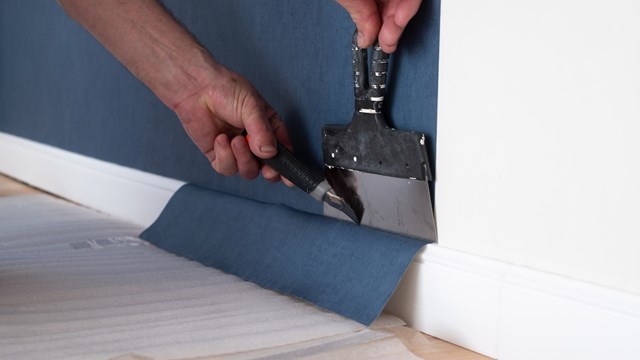
Some of us will never forget the ultimate question posed by Paris Hilton on the reality show The Simple Life. The overly coiffed, highly-manicured Hilton was “roughing it” by bunking with a working-class family in middle America and when a family trip to Walmart was scheduled, Hilton’s query (which now lives in infamy) was: “Walmart…do they like, make walls there?”
Most of the viewing audience rolled their eyes hard and we went on clicking channels. But perhaps Hilton’s question was deeper than we thought. How DO you get the wall you want? After the construction crew has departed from a new development or a capital improvement site, you are often left with design choices and wall covering options. From building to building, co-op and condo design committees, boards and individual apartment owners might differ wildly on how they choose to cover and decorate their walls. Changing trends, emerging fashions in interior design and of course, budget, all factor in to the decision making process.
A Matter of Taste
“I love, love, love my building,” says Manhattan resident Betsey L. “But I hate, hate, hate the common area walls. It’s this kind of hospital-waiting room blue color. I don’t know how else to describe it. It’s not a rich, deep blue and it isn’t a light robin’s-egg. It’s like if the color blue got carsick, this is what it would look like.” Betsey says she can’t convince her condo association to repaint it. “I think they don’t actually like the color either but the budget doesn’t really support a new paint job, and it technically doesn’t need to be repainted, so I’m just keeping my head down while I wait for the elevator…and for the day when we repaint.”
While we hope that the color suits your taste, regardless the most common kind of wallcoverings used in New York City co-op and condo building public and common areas are “Type II vinyl, because of the durability and range of color and design,” says Amy Paolino, director of marketing for Manhattan-based New York Corridors, Inc.
Katie Bone, marketing and public relations manager at Innovations in Wallcoverings, Inc. in New York City concurs. “Typically you’ll find Type II vinyl wall covering in the hallways and elevator areas. Occasionally you’ll find a natural woven or non-vinyl applied in areas with less high traffic for dramatic effect. ”
According to the The Wallcoverings Association (WA), Type II vinyl is a “medium or heavy duty vinyl, best used for foyers, loungers, corridors and classrooms, or areas of average to heavy scuffing. Type I vinyl is light duty, best used for office areas, hospital patient rooms and hotel rooms, as well as ceilings and areas of light abrasion.”
Bone explains that “Typically most designers want a wallcovering design that will fit the style of the building (i.e. transitional, traditional, modern) and then of course for the high traffic halls and rooms they’ll ask for a Type II, whether a vinyl or non-vinyl, to ensure that the design wears well over time.” Paolino suggests wall coverings that are scoff and rip resistant for all those clumsy movers who might scrape a couch leg across the elevator lobby wall or for runaway mail or grocery carts.
Whether choosing a Type I or Type II covering, The association lists the most popular types of wallcoverings as follows:
Vinyl Coated Paper:have a paper substrate on which the decorative surface has been sprayed or coated with an acrylic type vinyl or polyvinyl chloride (PVC);
Paper Backed Vinyl/Solid Sheet Vinyl:have a paper (pulp) substrate laminated to a solid decorative surface. These types of wallcoverings are very durable since the decorative surface is a solid sheet of vinyl. They are classified as scrubbable and peelable;
Fabric Backed Vinyl:have a woven substrate of fabric or a non-woven synthetic substrate. In either case, the substrate is laminated to a solid vinyl decorative surface.
Other Considerations
Design committees and residents can’t think of durability and long-lasting options alone, or they’ll be stuck with Betsey’s unhappy blue. While taking into consideration the lifespan of your wallcovering, you also want to consider the aesthetics.
“Typically eye catching wallcoverings are considered and selected for lobby areas. Designers can choose from custom digital murals to glamorous tile wallcoverings, like Innovations in Wallcoverings, Inc.’s Oceana collection, and woven grasscloths…these usually speak to the sophistication of the building and many times the architecture as well,” says Bone. Paolino adds, “In my experience, most designers coordinate furniture, painting, light temperature color and textiles to blend into a style that is representative of the building and pleasing to the eye.”
Residents should also consider wallpaper as a covering candidate. Though wallpaper often gets a bad rap as dated and stale (we certainly understand that after living through the brown wallpaper tones of the ‘70s and ‘80s), Paolino and Bone say its wallpaper’s time to shine.
“Wallpaper has never left the scene!,” says Paolino. “Common areas that have been redesigned or renovated use wallpaper 95% of the time.” Bone concurs; “Did it ever go out of style? Seriously, it’s a huge part of so many designer’s palettes since the walls are such a huge part of condo/co-op buildings or really most interiors. There are so many incredible wallcovering products available to designers and many see the wallcovering as the ‘artwork’ for their designs.”
Oprah’s designer BFF Nate Berkus recently declared that wallpaper has made a comeback, and The Wallcoverings Association praised wallpaper saying, “Wallpaper not only adds color to a room but it can also create added interest and solve decorating dilemmas. Wallpaper can manipulate spaces, add or eliminate architectural detail, even be applied on objects besides walls.”
Beyond Paper
Even trendier than wallpaper are some of the new wallcovering styles and options. Bone says “Woven sisals/bamboos/silks for the less high traffic areas are popular, leather and faux leather can be found in tile format also, which has such a luxe appeal to it,” says Bone. “Vinyls for the higher traffic areas with a realistic emboss recreating looks such as grasscloths, silks, stuccos and concrete. There area a number of new embossed Type II wallcoverings coming out in our summer collection that beautifully mimic grasscloths, shagreen, and natural linen. We also have some really striking cork wallcoverings, which are very on-trend at the moment…and some captivating constructions utilizing materials like recycled newspaper and capiz shells.”
If you aren’t ready to jump on (or back on) the wallpaper bandwagon or have to Google “capiz shells” to know what they are, there are a lot of options of simple interior paint for your common spaces, just make sure you are following regulations and staying green. Paolino points out that, “Most buildings insist on green products that contain low VOC's: volatile organic compounds—organic chemicals that have a high vapor pressure at ordinary room temperature. Their high vapor pressure results from a low boiling point, which causes large numbers of molecules to evaporate or sublimate from the liquid or solid form of the compound and enter the surrounding air.” Most paint suppliers, from Home Depot to Lowe's carry a number of low-VOC brand paints like Benjamin Moore and Behr.
The Cost of Chic
You’ve considered the aesthetic and the material, but what about cost? If the sky is the limit and you cost is no object for your building to redo your lobbies and hallways, some of the most luxe wall treatments and designs can really up the wow factor for residents and guests. And if you have the means, we highly recommend it. Paolino suggests “all different types of millwork, from classical styles to heavy woods to ultra-modern contemporary looks. Incorporating LED lighting, high tech flooring as well as traditional granites, marbles and terrazzos, automatic doors…and state of the art notification systems can make a beautiful luxe design,” says Paolino.
Bone offers additional suggestions, “Linens, silks, banana bark…newspaper, natural abaca and rattan. These items are ideal for focal walls and accent areas…I particularly love Bora, a natural banana bark wallcovering sold in panels, and Borneo, a striking woven construction of crushed capiz shells with a pattern reminiscent of snakeskin.”
But if you are watching your dollars and cents and can’t afford banana chips, let alone banana bark, never fear! “Buildings on a budget, no problem!” says Paolino. “Painting over worn and torn millwork can make it look new again at a fraction of the price of redoing.” Bone suggests that thinking outside the box can be done on a budget. “Digital prints are always a nice idea to consider as they are completely custom and usually budget friendly, allowing designers to bring a high end look to building on a tight budget. Also, vinyl interpretations of natural, higher end wallcoverings are always a nice idea as well; the same goes for the hallways with a beautiful vinyl interpretation.”
For residents like Betsey L., their budget and design decision will probably fall somewhere between new coats of paint and woven wallcoverings. “I think ultimately a choice of something more neutral, less offensive is the best thing for my building,” she says. “Something simple but durable— a tough neutral!” she says with a laugh.
Rebecca Fons is a freelance writer and a frequent contributor to The Cooperator.






Leave a Comment